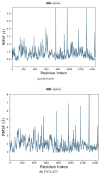In-Silico Molecular Modeling Studies to Identify Novel Potential Inhibitors of HPV E6 Protein
- PMID: 36146532
- PMCID: PMC9505724
- DOI: 10.3390/vaccines10091452
In-Silico Molecular Modeling Studies to Identify Novel Potential Inhibitors of HPV E6 Protein
Abstract
The etiological agent of some anogenital tract cancers is infection with the high-risk human papillomavirus (HPV). Currently, prophylactic vaccines against HPV have been validated, but the presence of drug treatment directed against the infection and its oncogenic effects remain essential. Among the best drug targets, viral oncoprotein E6 has been identified as a key factor in cell immortalization and tumor progression in HPV-positive cells. E6, through interaction with the cellular ubiquitin ligase E6AP, can promote the degradation of p53, a tumor suppressor protein. Therefore, suppression of the creation of the E6-E6AP complex is one of the essential strategies to inhibit the survival and proliferation of infected cells. In the present study, we proposed an in-silico approach for the discovery of small molecules with inhibitory activity on the E6-E6AP interaction. The first three compounds (F0679-0355, F33774-0275, and F3345-0326) were selected on the basis of virtual screening and prediction of the molecules' ADMET properties and docking with E6 protein, these molecules were selected for further study by investigating their stability in the E6 complex and their inhibitory effect on the E6-E6AP interaction by molecular dynamics (MD) simulation. The identified molecules thus represent a good starting point for the development of anti-HPV drugs.
Keywords: ADMET properties; E6-E6AP; MD simulations; cervical cancer; docking; virtual screening.
Conflict of interest statement
We wish to confirm that there are no known conflict of interest associated with this publication, and there has been no significant financial support for this work that could have influenced its outcome.
Figures













Similar articles
-
Molecular modeling simulation studies reveal new potential inhibitors against HPV E6 protein.PLoS One. 2019 Mar 15;14(3):e0213028. doi: 10.1371/journal.pone.0213028. eCollection 2019. PLoS One. 2019. PMID: 30875378 Free PMC article.
-
Targeting of HPV E6 at the binding sites to the host-cell E6AP, p53, and the endoplasmic reticulum-resident chaperone, GRP78.J Biomol Struct Dyn. 2024;42(22):12385-12395. doi: 10.1080/07391102.2023.2270067. Epub 2023 Oct 14. J Biomol Struct Dyn. 2024. PMID: 37837442
-
Ubiquitination of the HPV Oncoprotein E6 Is Critical for E6/E6AP-Mediated p53 Degradation.Front Microbiol. 2019 Oct 31;10:2483. doi: 10.3389/fmicb.2019.02483. eCollection 2019. Front Microbiol. 2019. PMID: 31749782 Free PMC article.
-
The role of TP53 in Cervical carcinogenesis.Hum Mutat. 2003 Mar;21(3):307-12. doi: 10.1002/humu.10178. Hum Mutat. 2003. PMID: 12619117 Review.
-
Fragment-based design and MD simulations of human papilloma virus-16 E6 protein inhibitors.J Biomol Struct Dyn. 2024 Jan-Feb;42(1):288-297. doi: 10.1080/07391102.2023.2203775. Epub 2023 Apr 26. J Biomol Struct Dyn. 2024. PMID: 37098806 Review.
Cited by
-
SARS-CoV-2 neutralizing antibody determination after vaccination using spectrophotometric measurement of lateral flow immunochromatography.Sci Rep. 2025 Feb 24;15(1):6577. doi: 10.1038/s41598-025-90730-9. Sci Rep. 2025. PMID: 39994387 Free PMC article.
-
In Silico Identification of Potential Antagonists Targeting the HPV16 E2-E1 Interaction: A Step Toward Novel Therapeutics for Cervical Cancer.Curr Issues Mol Biol. 2025 Apr 18;47(4):288. doi: 10.3390/cimb47040288. Curr Issues Mol Biol. 2025. PMID: 40699687 Free PMC article.
-
Protein ubiquitination in ovarian cancer immunotherapy: The progress and therapeutic strategy.Genes Dis. 2023 Oct 29;11(6):101158. doi: 10.1016/j.gendis.2023.101158. eCollection 2024 Nov. Genes Dis. 2023. PMID: 39253578 Free PMC article. Review.
-
The potential role of HPV oncoproteins in the PD-L1/PD-1 pathway in cervical cancer: new perspectives on cervical cancer immunotherapy.Front Oncol. 2024 Dec 13;14:1488730. doi: 10.3389/fonc.2024.1488730. eCollection 2024. Front Oncol. 2024. PMID: 39735605 Free PMC article. Review.
-
Genetic analysis of HPV-16 L1 gene mutations and computational screening of therapeutic inhibitors for cervical cancer treatment.Med Oncol. 2025 Apr 7;42(5):153. doi: 10.1007/s12032-025-02711-7. Med Oncol. 2025. PMID: 40192871
References
-
- Carper M.B., Goel S., Zhang A.M., Damrauer J.S., Cohen S., Zimmerman M.P., Gentile G.M., Parag-Sharma K., Murphy R.M., Sato K., et al. Activation of the CREB Coactivator CRTC2 by Aberrant Mitogen Signaling Promotes Oncogenic Functions in HPV16 Positive Head and Neck Cancer. Neoplasia. 2022;29:100799. doi: 10.1016/j.neo.2022.100799. - DOI - PMC - PubMed
LinkOut - more resources
Full Text Sources
Research Materials
Miscellaneous

